Balancing Ethics and Self-Determination in Social Work
VerifiedAdded on 2021/04/17
|13
|2946
|35
AI Summary
This assignment delves into the complexities of balancing social work ethics and a client's self-determination rights. A scenario is presented where a social worker must decide whether to inform a minor's parents about their child's mental health concerns, despite the child's reluctance. The assignment requires an analysis of the conflict between social work values and self-determination, with a focus on the principles of beneficence and non-maleficence. It also touches upon the importance of cultural competence and the role of professional ethics in guiding decision-making.
Contribute Materials
Your contribution can guide someone’s learning journey. Share your
documents today.
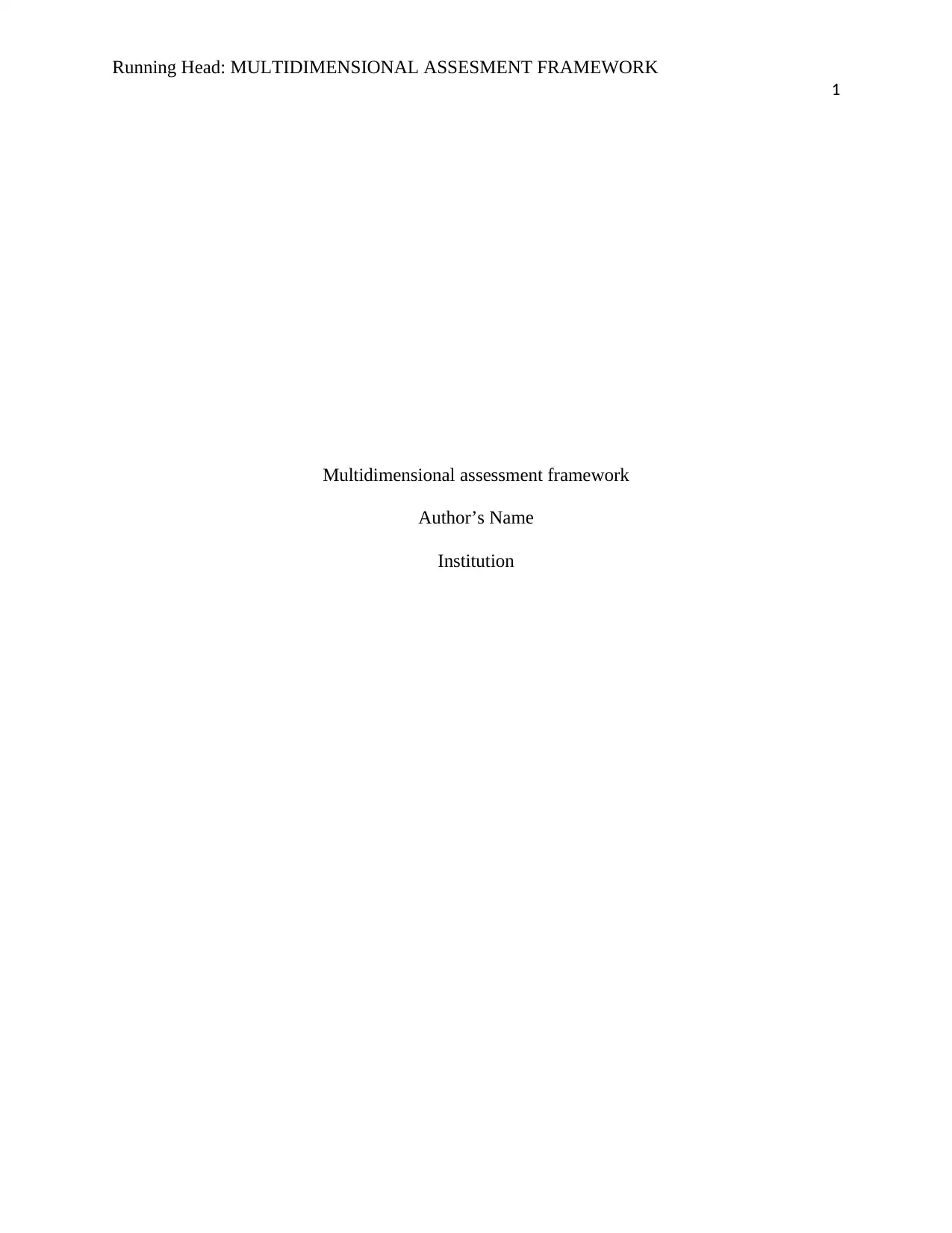
Running Head: MULTIDIMENSIONAL ASSESMENT FRAMEWORK
1
Multidimensional assessment framework
Author’s Name
Institution
1
Multidimensional assessment framework
Author’s Name
Institution
Secure Best Marks with AI Grader
Need help grading? Try our AI Grader for instant feedback on your assignments.
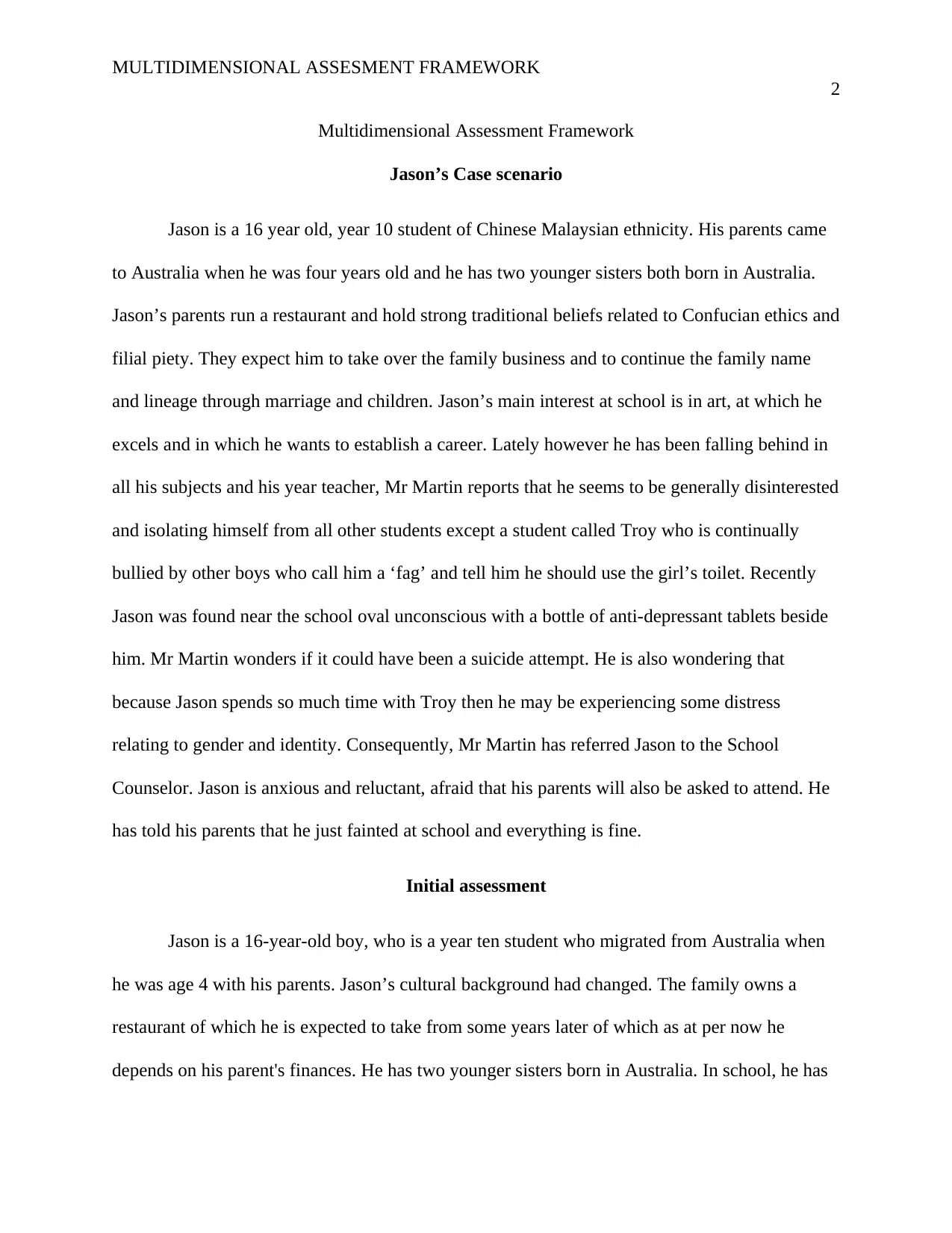
MULTIDIMENSIONAL ASSESMENT FRAMEWORK
2
Multidimensional Assessment Framework
Jason’s Case scenario
Jason is a 16 year old, year 10 student of Chinese Malaysian ethnicity. His parents came
to Australia when he was four years old and he has two younger sisters both born in Australia.
Jason’s parents run a restaurant and hold strong traditional beliefs related to Confucian ethics and
filial piety. They expect him to take over the family business and to continue the family name
and lineage through marriage and children. Jason’s main interest at school is in art, at which he
excels and in which he wants to establish a career. Lately however he has been falling behind in
all his subjects and his year teacher, Mr Martin reports that he seems to be generally disinterested
and isolating himself from all other students except a student called Troy who is continually
bullied by other boys who call him a ‘fag’ and tell him he should use the girl’s toilet. Recently
Jason was found near the school oval unconscious with a bottle of anti-depressant tablets beside
him. Mr Martin wonders if it could have been a suicide attempt. He is also wondering that
because Jason spends so much time with Troy then he may be experiencing some distress
relating to gender and identity. Consequently, Mr Martin has referred Jason to the School
Counselor. Jason is anxious and reluctant, afraid that his parents will also be asked to attend. He
has told his parents that he just fainted at school and everything is fine.
Initial assessment
Jason is a 16-year-old boy, who is a year ten student who migrated from Australia when
he was age 4 with his parents. Jason’s cultural background had changed. The family owns a
restaurant of which he is expected to take from some years later of which as at per now he
depends on his parent's finances. He has two younger sisters born in Australia. In school, he has
2
Multidimensional Assessment Framework
Jason’s Case scenario
Jason is a 16 year old, year 10 student of Chinese Malaysian ethnicity. His parents came
to Australia when he was four years old and he has two younger sisters both born in Australia.
Jason’s parents run a restaurant and hold strong traditional beliefs related to Confucian ethics and
filial piety. They expect him to take over the family business and to continue the family name
and lineage through marriage and children. Jason’s main interest at school is in art, at which he
excels and in which he wants to establish a career. Lately however he has been falling behind in
all his subjects and his year teacher, Mr Martin reports that he seems to be generally disinterested
and isolating himself from all other students except a student called Troy who is continually
bullied by other boys who call him a ‘fag’ and tell him he should use the girl’s toilet. Recently
Jason was found near the school oval unconscious with a bottle of anti-depressant tablets beside
him. Mr Martin wonders if it could have been a suicide attempt. He is also wondering that
because Jason spends so much time with Troy then he may be experiencing some distress
relating to gender and identity. Consequently, Mr Martin has referred Jason to the School
Counselor. Jason is anxious and reluctant, afraid that his parents will also be asked to attend. He
has told his parents that he just fainted at school and everything is fine.
Initial assessment
Jason is a 16-year-old boy, who is a year ten student who migrated from Australia when
he was age 4 with his parents. Jason’s cultural background had changed. The family owns a
restaurant of which he is expected to take from some years later of which as at per now he
depends on his parent's finances. He has two younger sisters born in Australia. In school, he has
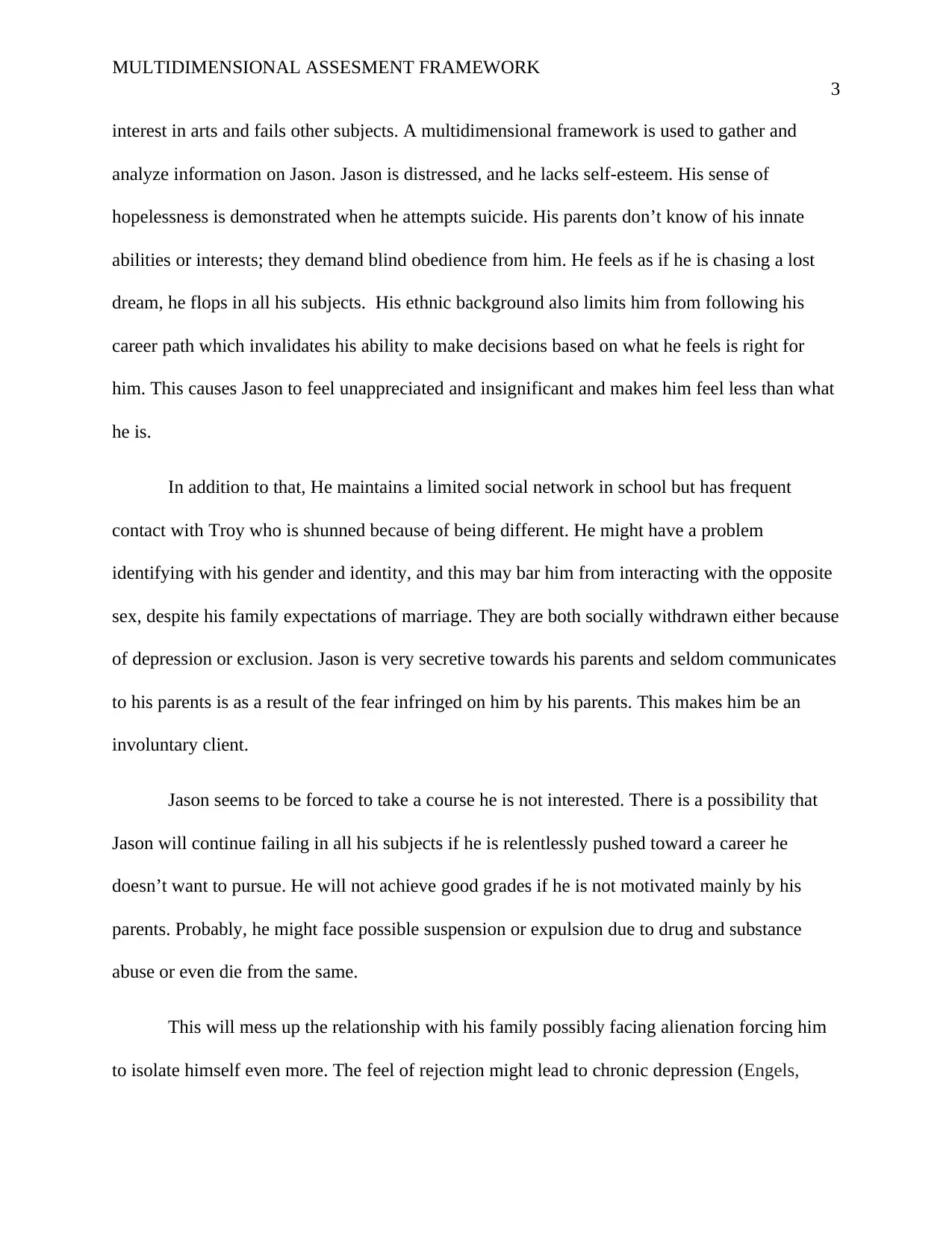
MULTIDIMENSIONAL ASSESMENT FRAMEWORK
3
interest in arts and fails other subjects. A multidimensional framework is used to gather and
analyze information on Jason. Jason is distressed, and he lacks self-esteem. His sense of
hopelessness is demonstrated when he attempts suicide. His parents don’t know of his innate
abilities or interests; they demand blind obedience from him. He feels as if he is chasing a lost
dream, he flops in all his subjects. His ethnic background also limits him from following his
career path which invalidates his ability to make decisions based on what he feels is right for
him. This causes Jason to feel unappreciated and insignificant and makes him feel less than what
he is.
In addition to that, He maintains a limited social network in school but has frequent
contact with Troy who is shunned because of being different. He might have a problem
identifying with his gender and identity, and this may bar him from interacting with the opposite
sex, despite his family expectations of marriage. They are both socially withdrawn either because
of depression or exclusion. Jason is very secretive towards his parents and seldom communicates
to his parents is as a result of the fear infringed on him by his parents. This makes him be an
involuntary client.
Jason seems to be forced to take a course he is not interested. There is a possibility that
Jason will continue failing in all his subjects if he is relentlessly pushed toward a career he
doesn’t want to pursue. He will not achieve good grades if he is not motivated mainly by his
parents. Probably, he might face possible suspension or expulsion due to drug and substance
abuse or even die from the same.
This will mess up the relationship with his family possibly facing alienation forcing him
to isolate himself even more. The feel of rejection might lead to chronic depression (Engels,
3
interest in arts and fails other subjects. A multidimensional framework is used to gather and
analyze information on Jason. Jason is distressed, and he lacks self-esteem. His sense of
hopelessness is demonstrated when he attempts suicide. His parents don’t know of his innate
abilities or interests; they demand blind obedience from him. He feels as if he is chasing a lost
dream, he flops in all his subjects. His ethnic background also limits him from following his
career path which invalidates his ability to make decisions based on what he feels is right for
him. This causes Jason to feel unappreciated and insignificant and makes him feel less than what
he is.
In addition to that, He maintains a limited social network in school but has frequent
contact with Troy who is shunned because of being different. He might have a problem
identifying with his gender and identity, and this may bar him from interacting with the opposite
sex, despite his family expectations of marriage. They are both socially withdrawn either because
of depression or exclusion. Jason is very secretive towards his parents and seldom communicates
to his parents is as a result of the fear infringed on him by his parents. This makes him be an
involuntary client.
Jason seems to be forced to take a course he is not interested. There is a possibility that
Jason will continue failing in all his subjects if he is relentlessly pushed toward a career he
doesn’t want to pursue. He will not achieve good grades if he is not motivated mainly by his
parents. Probably, he might face possible suspension or expulsion due to drug and substance
abuse or even die from the same.
This will mess up the relationship with his family possibly facing alienation forcing him
to isolate himself even more. The feel of rejection might lead to chronic depression (Engels,
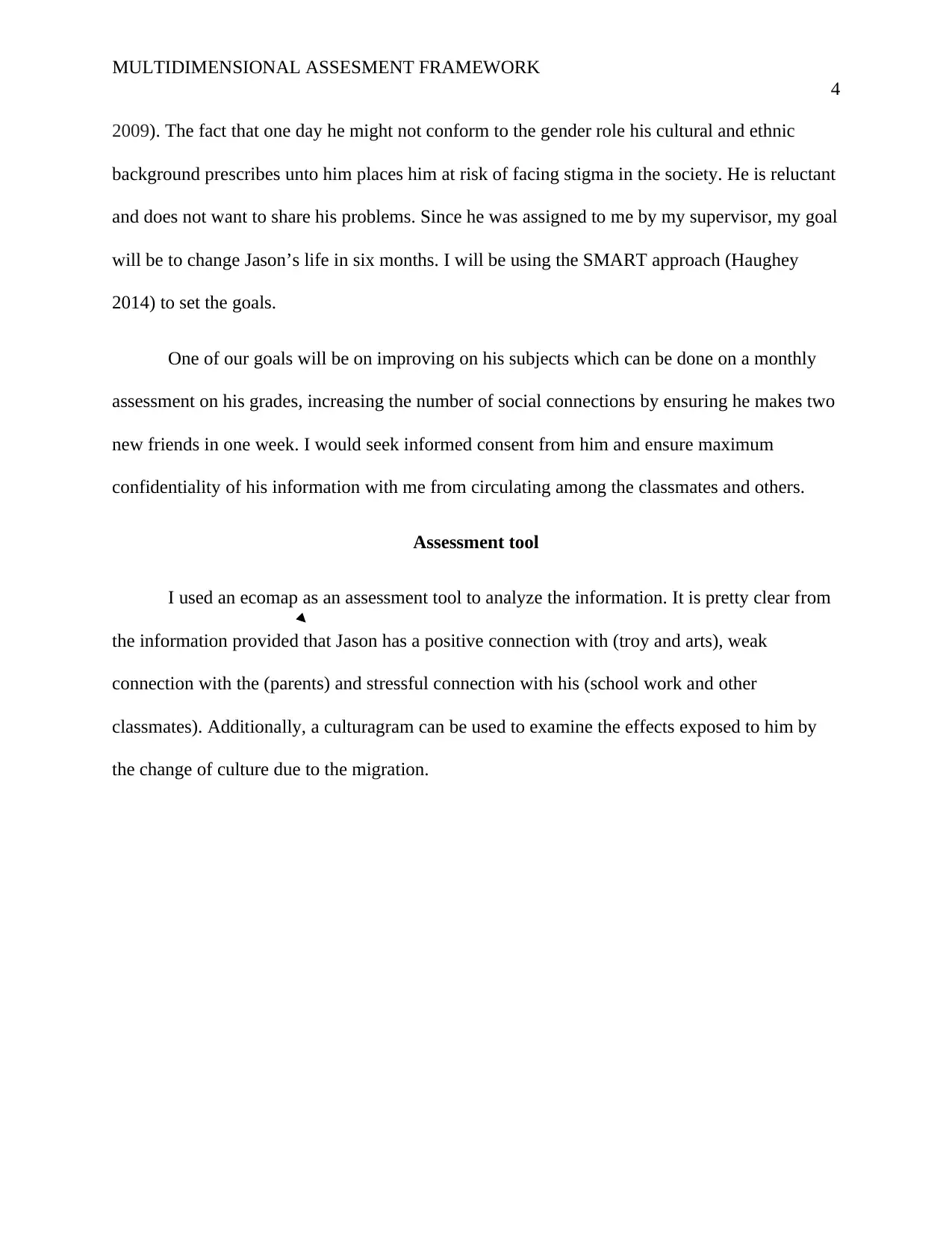
MULTIDIMENSIONAL ASSESMENT FRAMEWORK
4
2009). The fact that one day he might not conform to the gender role his cultural and ethnic
background prescribes unto him places him at risk of facing stigma in the society. He is reluctant
and does not want to share his problems. Since he was assigned to me by my supervisor, my goal
will be to change Jason’s life in six months. I will be using the SMART approach (Haughey
2014) to set the goals.
One of our goals will be on improving on his subjects which can be done on a monthly
assessment on his grades, increasing the number of social connections by ensuring he makes two
new friends in one week. I would seek informed consent from him and ensure maximum
confidentiality of his information with me from circulating among the classmates and others.
Assessment tool
I used an ecomap as an assessment tool to analyze the information. It is pretty clear from
the information provided that Jason has a positive connection with (troy and arts), weak
connection with the (parents) and stressful connection with his (school work and other
classmates). Additionally, a culturagram can be used to examine the effects exposed to him by
the change of culture due to the migration.
4
2009). The fact that one day he might not conform to the gender role his cultural and ethnic
background prescribes unto him places him at risk of facing stigma in the society. He is reluctant
and does not want to share his problems. Since he was assigned to me by my supervisor, my goal
will be to change Jason’s life in six months. I will be using the SMART approach (Haughey
2014) to set the goals.
One of our goals will be on improving on his subjects which can be done on a monthly
assessment on his grades, increasing the number of social connections by ensuring he makes two
new friends in one week. I would seek informed consent from him and ensure maximum
confidentiality of his information with me from circulating among the classmates and others.
Assessment tool
I used an ecomap as an assessment tool to analyze the information. It is pretty clear from
the information provided that Jason has a positive connection with (troy and arts), weak
connection with the (parents) and stressful connection with his (school work and other
classmates). Additionally, a culturagram can be used to examine the effects exposed to him by
the change of culture due to the migration.
Secure Best Marks with AI Grader
Need help grading? Try our AI Grader for instant feedback on your assignments.

MULTIDIMENSIONAL ASSESMENT FRAMEWORK
5
5
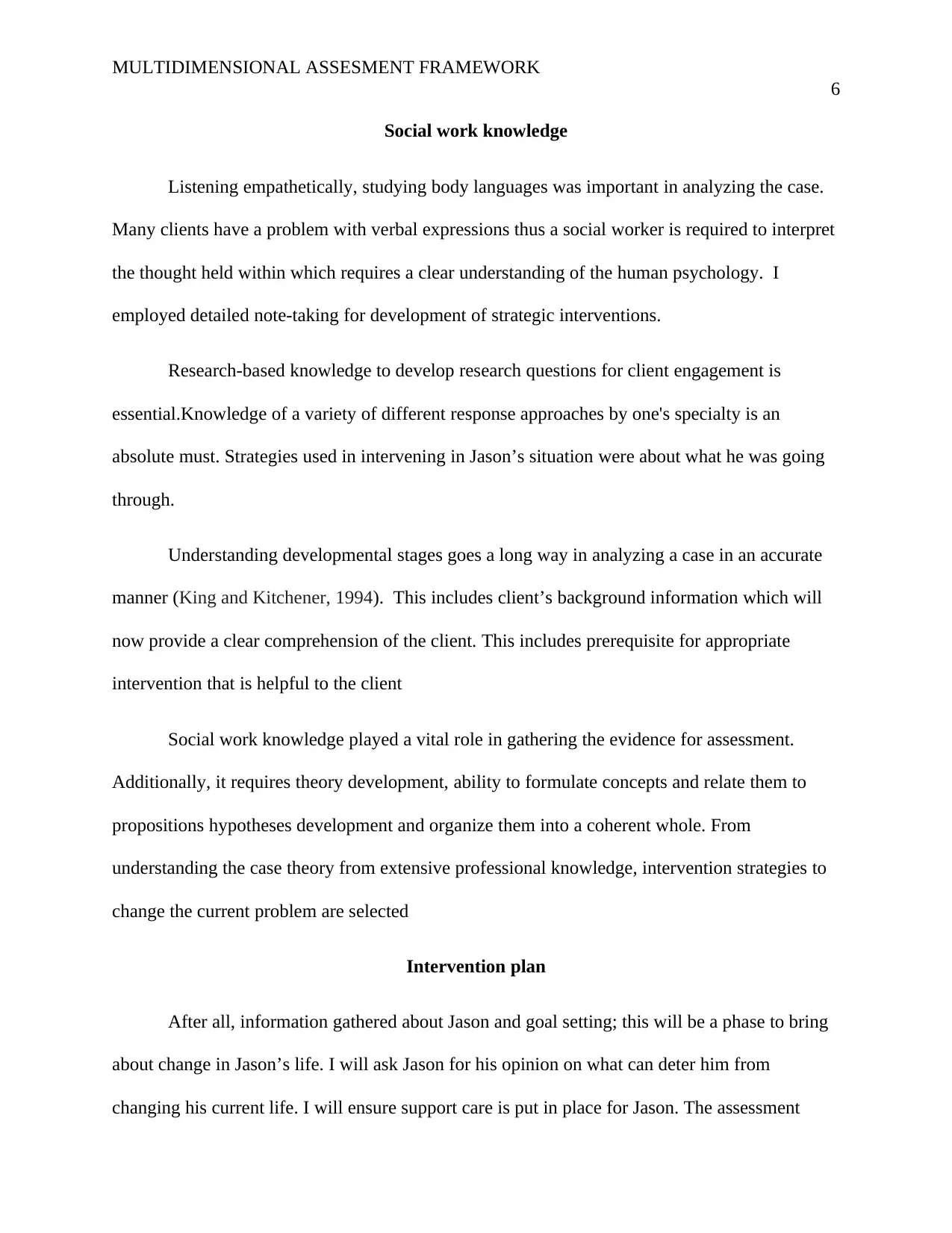
MULTIDIMENSIONAL ASSESMENT FRAMEWORK
6
Social work knowledge
Listening empathetically, studying body languages was important in analyzing the case.
Many clients have a problem with verbal expressions thus a social worker is required to interpret
the thought held within which requires a clear understanding of the human psychology. I
employed detailed note-taking for development of strategic interventions.
Research-based knowledge to develop research questions for client engagement is
essential.Knowledge of a variety of different response approaches by one's specialty is an
absolute must. Strategies used in intervening in Jason’s situation were about what he was going
through.
Understanding developmental stages goes a long way in analyzing a case in an accurate
manner (King and Kitchener, 1994). This includes client’s background information which will
now provide a clear comprehension of the client. This includes prerequisite for appropriate
intervention that is helpful to the client
Social work knowledge played a vital role in gathering the evidence for assessment.
Additionally, it requires theory development, ability to formulate concepts and relate them to
propositions hypotheses development and organize them into a coherent whole. From
understanding the case theory from extensive professional knowledge, intervention strategies to
change the current problem are selected
Intervention plan
After all, information gathered about Jason and goal setting; this will be a phase to bring
about change in Jason’s life. I will ask Jason for his opinion on what can deter him from
changing his current life. I will ensure support care is put in place for Jason. The assessment
6
Social work knowledge
Listening empathetically, studying body languages was important in analyzing the case.
Many clients have a problem with verbal expressions thus a social worker is required to interpret
the thought held within which requires a clear understanding of the human psychology. I
employed detailed note-taking for development of strategic interventions.
Research-based knowledge to develop research questions for client engagement is
essential.Knowledge of a variety of different response approaches by one's specialty is an
absolute must. Strategies used in intervening in Jason’s situation were about what he was going
through.
Understanding developmental stages goes a long way in analyzing a case in an accurate
manner (King and Kitchener, 1994). This includes client’s background information which will
now provide a clear comprehension of the client. This includes prerequisite for appropriate
intervention that is helpful to the client
Social work knowledge played a vital role in gathering the evidence for assessment.
Additionally, it requires theory development, ability to formulate concepts and relate them to
propositions hypotheses development and organize them into a coherent whole. From
understanding the case theory from extensive professional knowledge, intervention strategies to
change the current problem are selected
Intervention plan
After all, information gathered about Jason and goal setting; this will be a phase to bring
about change in Jason’s life. I will ask Jason for his opinion on what can deter him from
changing his current life. I will ensure support care is put in place for Jason. The assessment
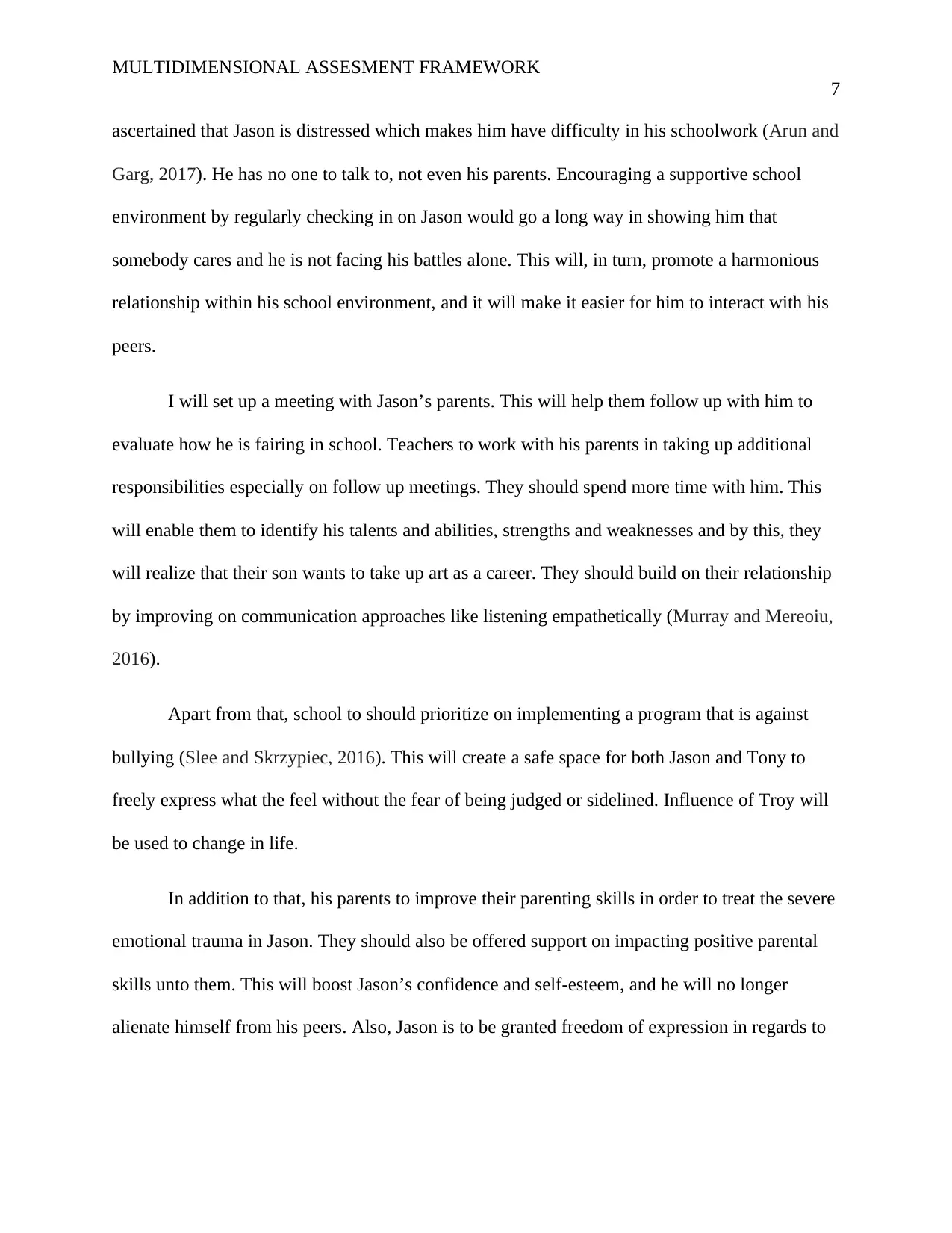
MULTIDIMENSIONAL ASSESMENT FRAMEWORK
7
ascertained that Jason is distressed which makes him have difficulty in his schoolwork (Arun and
Garg, 2017). He has no one to talk to, not even his parents. Encouraging a supportive school
environment by regularly checking in on Jason would go a long way in showing him that
somebody cares and he is not facing his battles alone. This will, in turn, promote a harmonious
relationship within his school environment, and it will make it easier for him to interact with his
peers.
I will set up a meeting with Jason’s parents. This will help them follow up with him to
evaluate how he is fairing in school. Teachers to work with his parents in taking up additional
responsibilities especially on follow up meetings. They should spend more time with him. This
will enable them to identify his talents and abilities, strengths and weaknesses and by this, they
will realize that their son wants to take up art as a career. They should build on their relationship
by improving on communication approaches like listening empathetically (Murray and Mereoiu,
2016).
Apart from that, school to should prioritize on implementing a program that is against
bullying (Slee and Skrzypiec, 2016). This will create a safe space for both Jason and Tony to
freely express what the feel without the fear of being judged or sidelined. Influence of Troy will
be used to change in life.
In addition to that, his parents to improve their parenting skills in order to treat the severe
emotional trauma in Jason. They should also be offered support on impacting positive parental
skills unto them. This will boost Jason’s confidence and self-esteem, and he will no longer
alienate himself from his peers. Also, Jason is to be granted freedom of expression in regards to
7
ascertained that Jason is distressed which makes him have difficulty in his schoolwork (Arun and
Garg, 2017). He has no one to talk to, not even his parents. Encouraging a supportive school
environment by regularly checking in on Jason would go a long way in showing him that
somebody cares and he is not facing his battles alone. This will, in turn, promote a harmonious
relationship within his school environment, and it will make it easier for him to interact with his
peers.
I will set up a meeting with Jason’s parents. This will help them follow up with him to
evaluate how he is fairing in school. Teachers to work with his parents in taking up additional
responsibilities especially on follow up meetings. They should spend more time with him. This
will enable them to identify his talents and abilities, strengths and weaknesses and by this, they
will realize that their son wants to take up art as a career. They should build on their relationship
by improving on communication approaches like listening empathetically (Murray and Mereoiu,
2016).
Apart from that, school to should prioritize on implementing a program that is against
bullying (Slee and Skrzypiec, 2016). This will create a safe space for both Jason and Tony to
freely express what the feel without the fear of being judged or sidelined. Influence of Troy will
be used to change in life.
In addition to that, his parents to improve their parenting skills in order to treat the severe
emotional trauma in Jason. They should also be offered support on impacting positive parental
skills unto them. This will boost Jason’s confidence and self-esteem, and he will no longer
alienate himself from his peers. Also, Jason is to be granted freedom of expression in regards to
Paraphrase This Document
Need a fresh take? Get an instant paraphrase of this document with our AI Paraphraser
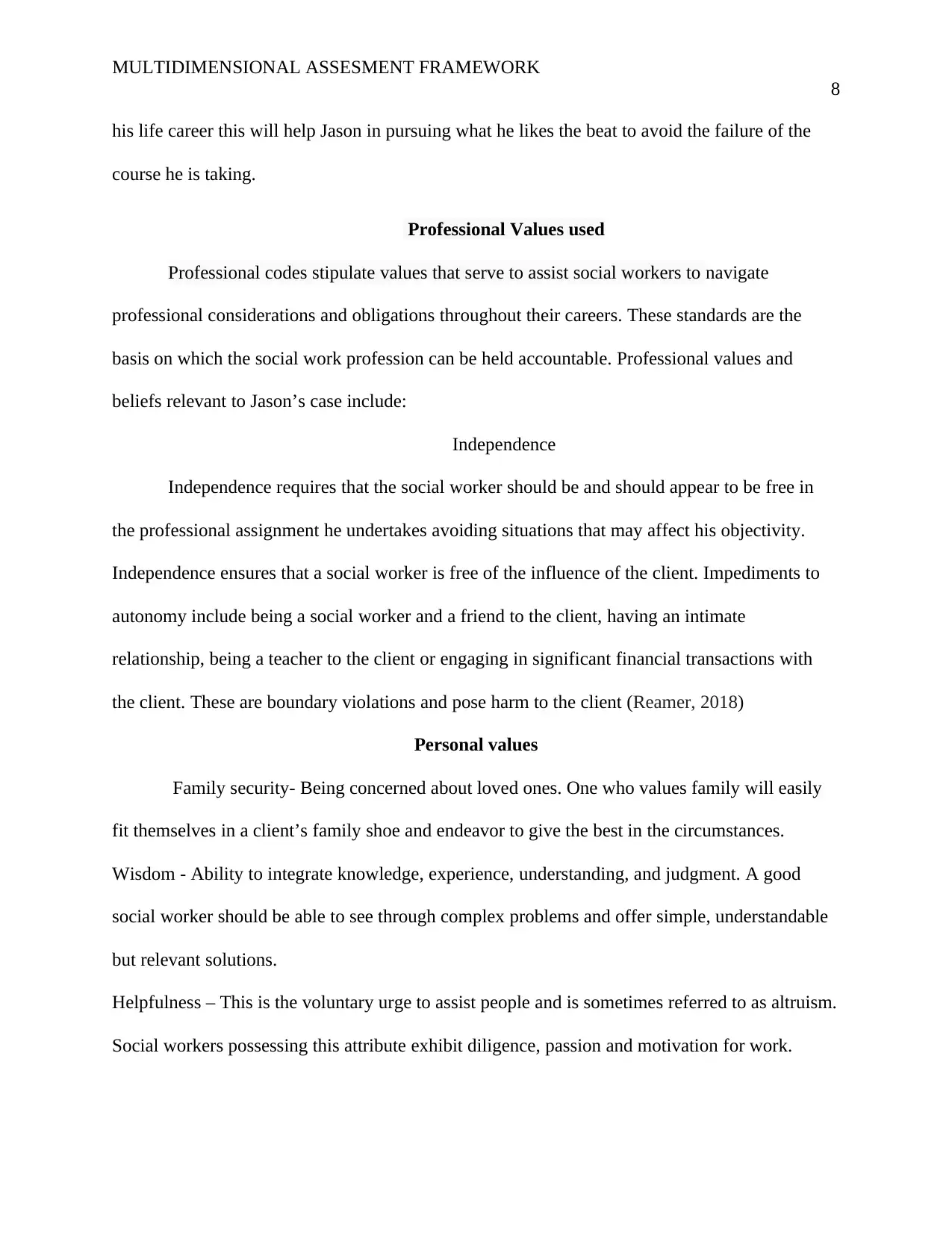
MULTIDIMENSIONAL ASSESMENT FRAMEWORK
8
his life career this will help Jason in pursuing what he likes the beat to avoid the failure of the
course he is taking.
Professional Values used
Professional codes stipulate values that serve to assist social workers to navigate
professional considerations and obligations throughout their careers. These standards are the
basis on which the social work profession can be held accountable. Professional values and
beliefs relevant to Jason’s case include:
Independence
Independence requires that the social worker should be and should appear to be free in
the professional assignment he undertakes avoiding situations that may affect his objectivity.
Independence ensures that a social worker is free of the influence of the client. Impediments to
autonomy include being a social worker and a friend to the client, having an intimate
relationship, being a teacher to the client or engaging in significant financial transactions with
the client. These are boundary violations and pose harm to the client (Reamer, 2018)
Personal values
Family security- Being concerned about loved ones. One who values family will easily
fit themselves in a client’s family shoe and endeavor to give the best in the circumstances.
Wisdom - Ability to integrate knowledge, experience, understanding, and judgment. A good
social worker should be able to see through complex problems and offer simple, understandable
but relevant solutions.
Helpfulness – This is the voluntary urge to assist people and is sometimes referred to as altruism.
Social workers possessing this attribute exhibit diligence, passion and motivation for work.
8
his life career this will help Jason in pursuing what he likes the beat to avoid the failure of the
course he is taking.
Professional Values used
Professional codes stipulate values that serve to assist social workers to navigate
professional considerations and obligations throughout their careers. These standards are the
basis on which the social work profession can be held accountable. Professional values and
beliefs relevant to Jason’s case include:
Independence
Independence requires that the social worker should be and should appear to be free in
the professional assignment he undertakes avoiding situations that may affect his objectivity.
Independence ensures that a social worker is free of the influence of the client. Impediments to
autonomy include being a social worker and a friend to the client, having an intimate
relationship, being a teacher to the client or engaging in significant financial transactions with
the client. These are boundary violations and pose harm to the client (Reamer, 2018)
Personal values
Family security- Being concerned about loved ones. One who values family will easily
fit themselves in a client’s family shoe and endeavor to give the best in the circumstances.
Wisdom - Ability to integrate knowledge, experience, understanding, and judgment. A good
social worker should be able to see through complex problems and offer simple, understandable
but relevant solutions.
Helpfulness – This is the voluntary urge to assist people and is sometimes referred to as altruism.
Social workers possessing this attribute exhibit diligence, passion and motivation for work.
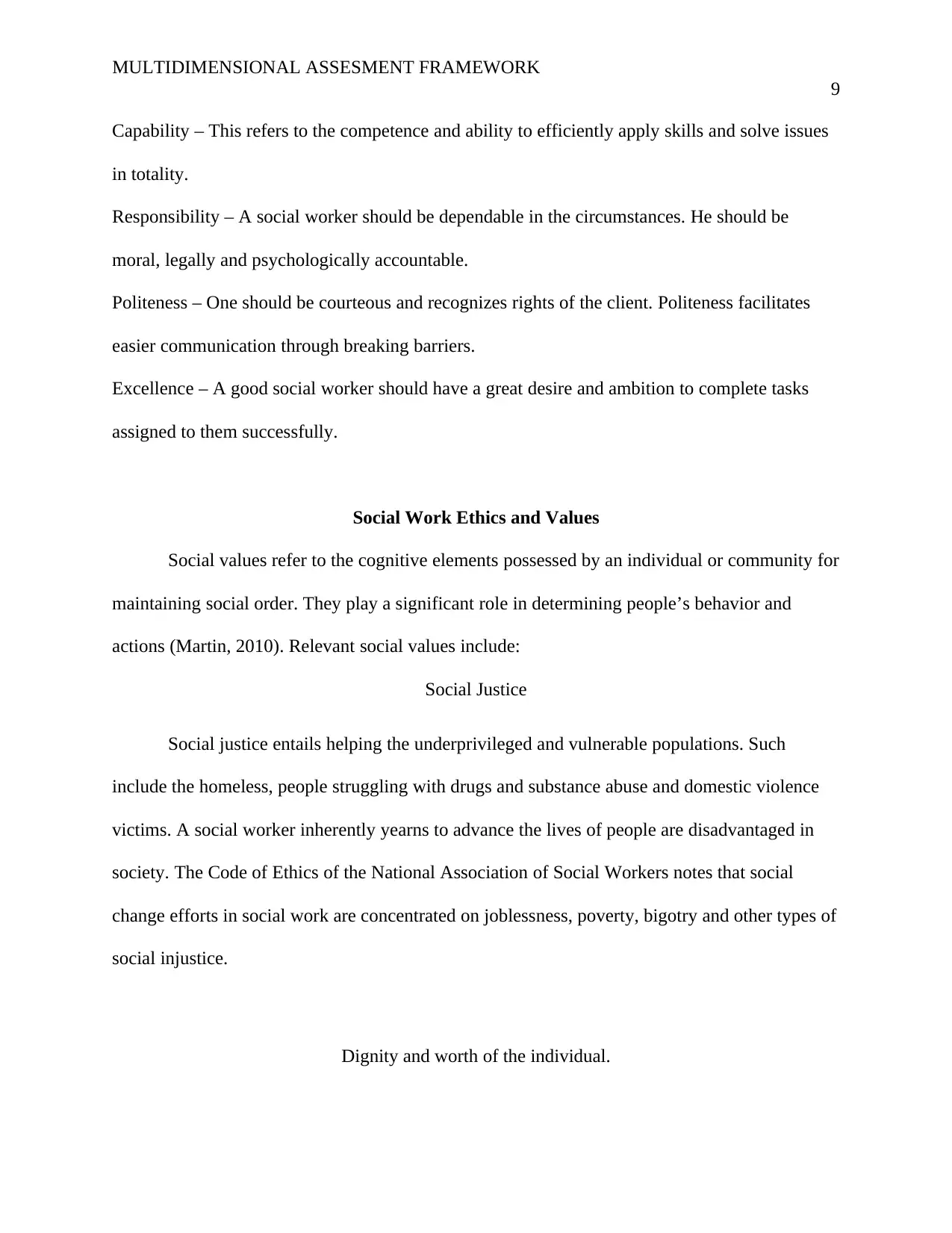
MULTIDIMENSIONAL ASSESMENT FRAMEWORK
9
Capability – This refers to the competence and ability to efficiently apply skills and solve issues
in totality.
Responsibility – A social worker should be dependable in the circumstances. He should be
moral, legally and psychologically accountable.
Politeness – One should be courteous and recognizes rights of the client. Politeness facilitates
easier communication through breaking barriers.
Excellence – A good social worker should have a great desire and ambition to complete tasks
assigned to them successfully.
Social Work Ethics and Values
Social values refer to the cognitive elements possessed by an individual or community for
maintaining social order. They play a significant role in determining people’s behavior and
actions (Martin, 2010). Relevant social values include:
Social Justice
Social justice entails helping the underprivileged and vulnerable populations. Such
include the homeless, people struggling with drugs and substance abuse and domestic violence
victims. A social worker inherently yearns to advance the lives of people are disadvantaged in
society. The Code of Ethics of the National Association of Social Workers notes that social
change efforts in social work are concentrated on joblessness, poverty, bigotry and other types of
social injustice.
Dignity and worth of the individual.
9
Capability – This refers to the competence and ability to efficiently apply skills and solve issues
in totality.
Responsibility – A social worker should be dependable in the circumstances. He should be
moral, legally and psychologically accountable.
Politeness – One should be courteous and recognizes rights of the client. Politeness facilitates
easier communication through breaking barriers.
Excellence – A good social worker should have a great desire and ambition to complete tasks
assigned to them successfully.
Social Work Ethics and Values
Social values refer to the cognitive elements possessed by an individual or community for
maintaining social order. They play a significant role in determining people’s behavior and
actions (Martin, 2010). Relevant social values include:
Social Justice
Social justice entails helping the underprivileged and vulnerable populations. Such
include the homeless, people struggling with drugs and substance abuse and domestic violence
victims. A social worker inherently yearns to advance the lives of people are disadvantaged in
society. The Code of Ethics of the National Association of Social Workers notes that social
change efforts in social work are concentrated on joblessness, poverty, bigotry and other types of
social injustice.
Dignity and worth of the individual.
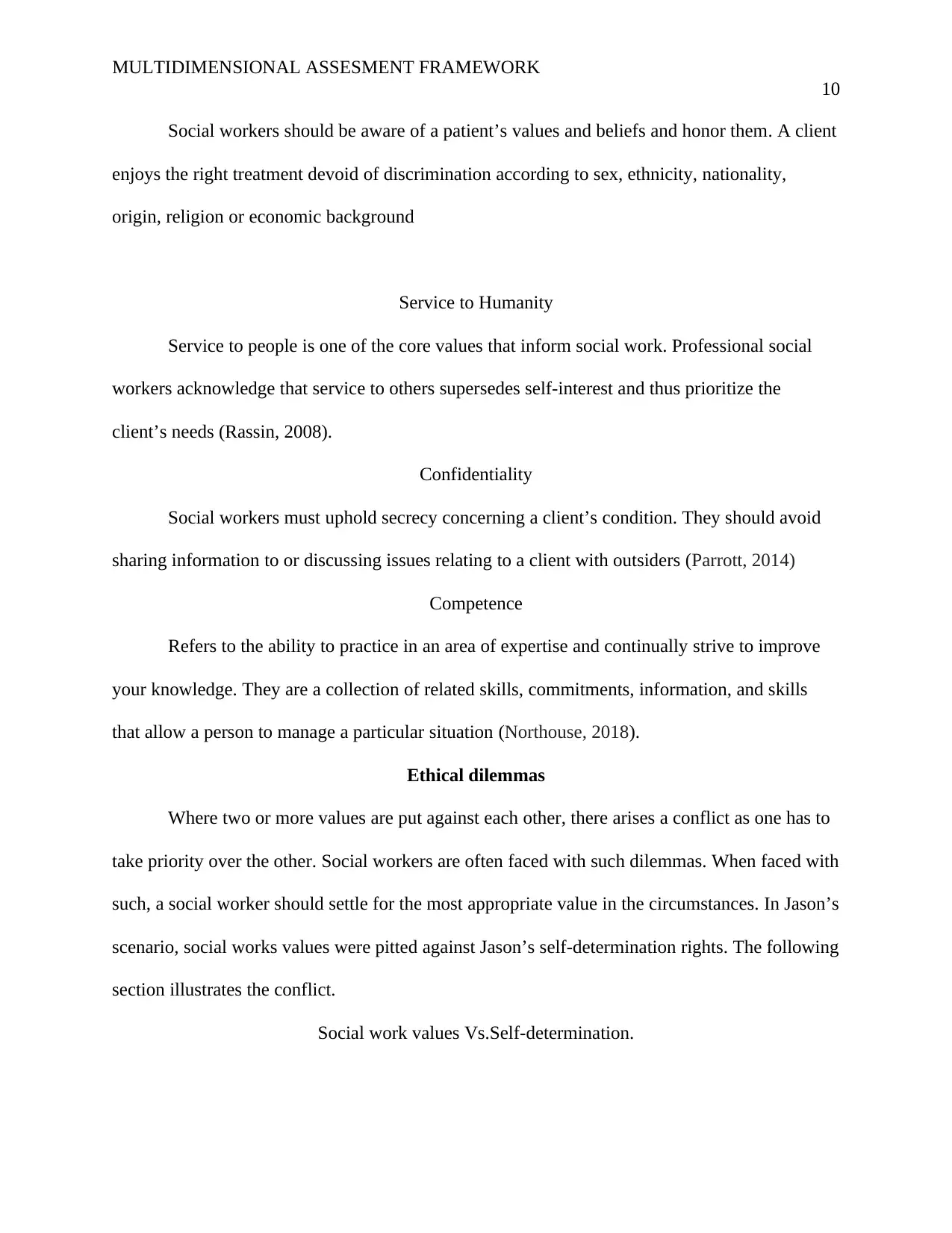
MULTIDIMENSIONAL ASSESMENT FRAMEWORK
10
Social workers should be aware of a patient’s values and beliefs and honor them. A client
enjoys the right treatment devoid of discrimination according to sex, ethnicity, nationality,
origin, religion or economic background
Service to Humanity
Service to people is one of the core values that inform social work. Professional social
workers acknowledge that service to others supersedes self-interest and thus prioritize the
client’s needs (Rassin, 2008).
Confidentiality
Social workers must uphold secrecy concerning a client’s condition. They should avoid
sharing information to or discussing issues relating to a client with outsiders (Parrott, 2014)
Competence
Refers to the ability to practice in an area of expertise and continually strive to improve
your knowledge. They are a collection of related skills, commitments, information, and skills
that allow a person to manage a particular situation (Northouse, 2018).
Ethical dilemmas
Where two or more values are put against each other, there arises a conflict as one has to
take priority over the other. Social workers are often faced with such dilemmas. When faced with
such, a social worker should settle for the most appropriate value in the circumstances. In Jason’s
scenario, social works values were pitted against Jason’s self-determination rights. The following
section illustrates the conflict.
Social work values Vs.Self-determination.
10
Social workers should be aware of a patient’s values and beliefs and honor them. A client
enjoys the right treatment devoid of discrimination according to sex, ethnicity, nationality,
origin, religion or economic background
Service to Humanity
Service to people is one of the core values that inform social work. Professional social
workers acknowledge that service to others supersedes self-interest and thus prioritize the
client’s needs (Rassin, 2008).
Confidentiality
Social workers must uphold secrecy concerning a client’s condition. They should avoid
sharing information to or discussing issues relating to a client with outsiders (Parrott, 2014)
Competence
Refers to the ability to practice in an area of expertise and continually strive to improve
your knowledge. They are a collection of related skills, commitments, information, and skills
that allow a person to manage a particular situation (Northouse, 2018).
Ethical dilemmas
Where two or more values are put against each other, there arises a conflict as one has to
take priority over the other. Social workers are often faced with such dilemmas. When faced with
such, a social worker should settle for the most appropriate value in the circumstances. In Jason’s
scenario, social works values were pitted against Jason’s self-determination rights. The following
section illustrates the conflict.
Social work values Vs.Self-determination.
Secure Best Marks with AI Grader
Need help grading? Try our AI Grader for instant feedback on your assignments.
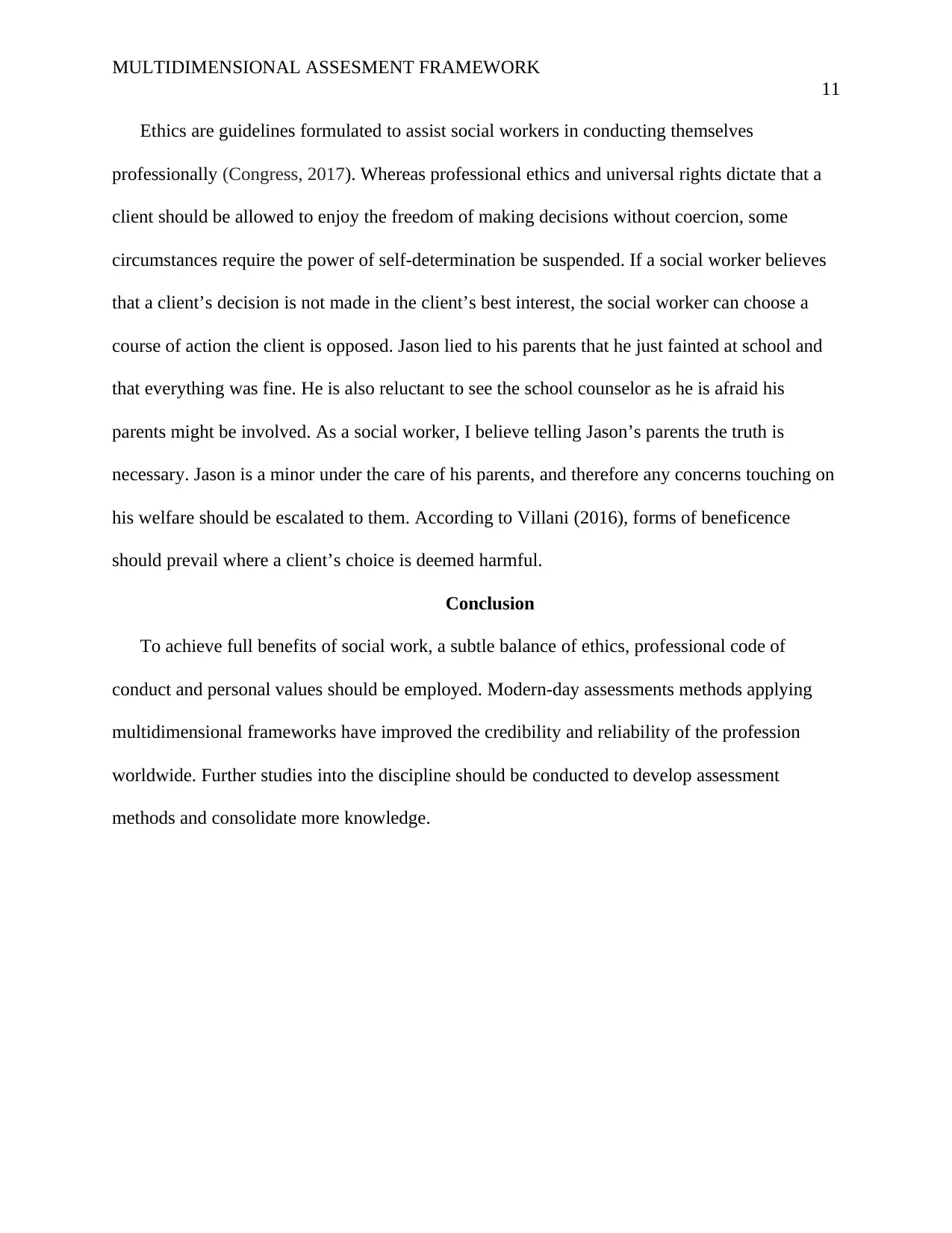
MULTIDIMENSIONAL ASSESMENT FRAMEWORK
11
Ethics are guidelines formulated to assist social workers in conducting themselves
professionally (Congress, 2017). Whereas professional ethics and universal rights dictate that a
client should be allowed to enjoy the freedom of making decisions without coercion, some
circumstances require the power of self-determination be suspended. If a social worker believes
that a client’s decision is not made in the client’s best interest, the social worker can choose a
course of action the client is opposed. Jason lied to his parents that he just fainted at school and
that everything was fine. He is also reluctant to see the school counselor as he is afraid his
parents might be involved. As a social worker, I believe telling Jason’s parents the truth is
necessary. Jason is a minor under the care of his parents, and therefore any concerns touching on
his welfare should be escalated to them. According to Villani (2016), forms of beneficence
should prevail where a client’s choice is deemed harmful.
Conclusion
To achieve full benefits of social work, a subtle balance of ethics, professional code of
conduct and personal values should be employed. Modern-day assessments methods applying
multidimensional frameworks have improved the credibility and reliability of the profession
worldwide. Further studies into the discipline should be conducted to develop assessment
methods and consolidate more knowledge.
11
Ethics are guidelines formulated to assist social workers in conducting themselves
professionally (Congress, 2017). Whereas professional ethics and universal rights dictate that a
client should be allowed to enjoy the freedom of making decisions without coercion, some
circumstances require the power of self-determination be suspended. If a social worker believes
that a client’s decision is not made in the client’s best interest, the social worker can choose a
course of action the client is opposed. Jason lied to his parents that he just fainted at school and
that everything was fine. He is also reluctant to see the school counselor as he is afraid his
parents might be involved. As a social worker, I believe telling Jason’s parents the truth is
necessary. Jason is a minor under the care of his parents, and therefore any concerns touching on
his welfare should be escalated to them. According to Villani (2016), forms of beneficence
should prevail where a client’s choice is deemed harmful.
Conclusion
To achieve full benefits of social work, a subtle balance of ethics, professional code of
conduct and personal values should be employed. Modern-day assessments methods applying
multidimensional frameworks have improved the credibility and reliability of the profession
worldwide. Further studies into the discipline should be conducted to develop assessment
methods and consolidate more knowledge.
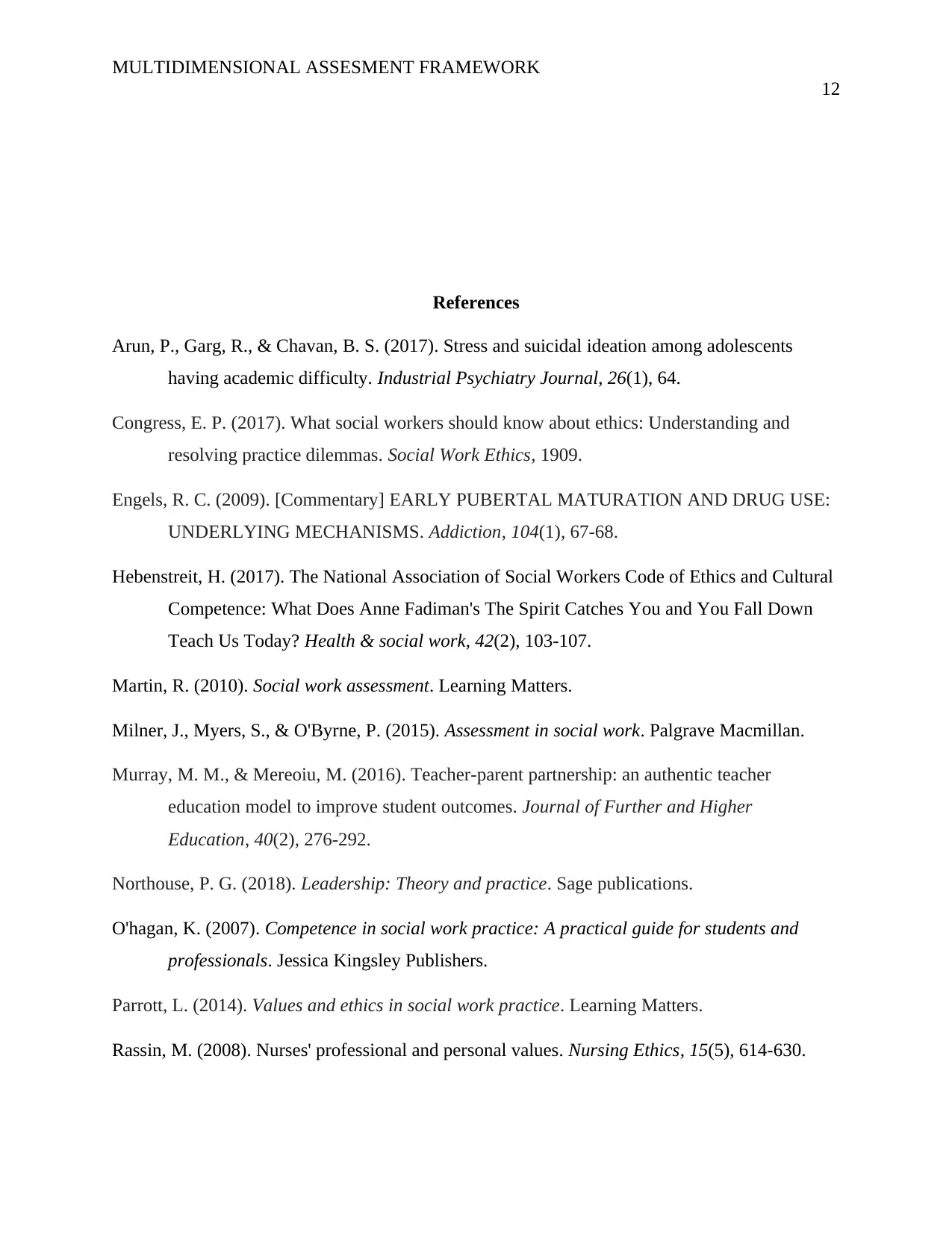
MULTIDIMENSIONAL ASSESMENT FRAMEWORK
12
References
Arun, P., Garg, R., & Chavan, B. S. (2017). Stress and suicidal ideation among adolescents
having academic difficulty. Industrial Psychiatry Journal, 26(1), 64.
Congress, E. P. (2017). What social workers should know about ethics: Understanding and
resolving practice dilemmas. Social Work Ethics, 1909.
Engels, R. C. (2009). [Commentary] EARLY PUBERTAL MATURATION AND DRUG USE:
UNDERLYING MECHANISMS. Addiction, 104(1), 67-68.
Hebenstreit, H. (2017). The National Association of Social Workers Code of Ethics and Cultural
Competence: What Does Anne Fadiman's The Spirit Catches You and You Fall Down
Teach Us Today? Health & social work, 42(2), 103-107.
Martin, R. (2010). Social work assessment. Learning Matters.
Milner, J., Myers, S., & O'Byrne, P. (2015). Assessment in social work. Palgrave Macmillan.
Murray, M. M., & Mereoiu, M. (2016). Teacher-parent partnership: an authentic teacher
education model to improve student outcomes. Journal of Further and Higher
Education, 40(2), 276-292.
Northouse, P. G. (2018). Leadership: Theory and practice. Sage publications.
O'hagan, K. (2007). Competence in social work practice: A practical guide for students and
professionals. Jessica Kingsley Publishers.
Parrott, L. (2014). Values and ethics in social work practice. Learning Matters.
Rassin, M. (2008). Nurses' professional and personal values. Nursing Ethics, 15(5), 614-630.
12
References
Arun, P., Garg, R., & Chavan, B. S. (2017). Stress and suicidal ideation among adolescents
having academic difficulty. Industrial Psychiatry Journal, 26(1), 64.
Congress, E. P. (2017). What social workers should know about ethics: Understanding and
resolving practice dilemmas. Social Work Ethics, 1909.
Engels, R. C. (2009). [Commentary] EARLY PUBERTAL MATURATION AND DRUG USE:
UNDERLYING MECHANISMS. Addiction, 104(1), 67-68.
Hebenstreit, H. (2017). The National Association of Social Workers Code of Ethics and Cultural
Competence: What Does Anne Fadiman's The Spirit Catches You and You Fall Down
Teach Us Today? Health & social work, 42(2), 103-107.
Martin, R. (2010). Social work assessment. Learning Matters.
Milner, J., Myers, S., & O'Byrne, P. (2015). Assessment in social work. Palgrave Macmillan.
Murray, M. M., & Mereoiu, M. (2016). Teacher-parent partnership: an authentic teacher
education model to improve student outcomes. Journal of Further and Higher
Education, 40(2), 276-292.
Northouse, P. G. (2018). Leadership: Theory and practice. Sage publications.
O'hagan, K. (2007). Competence in social work practice: A practical guide for students and
professionals. Jessica Kingsley Publishers.
Parrott, L. (2014). Values and ethics in social work practice. Learning Matters.
Rassin, M. (2008). Nurses' professional and personal values. Nursing Ethics, 15(5), 614-630.
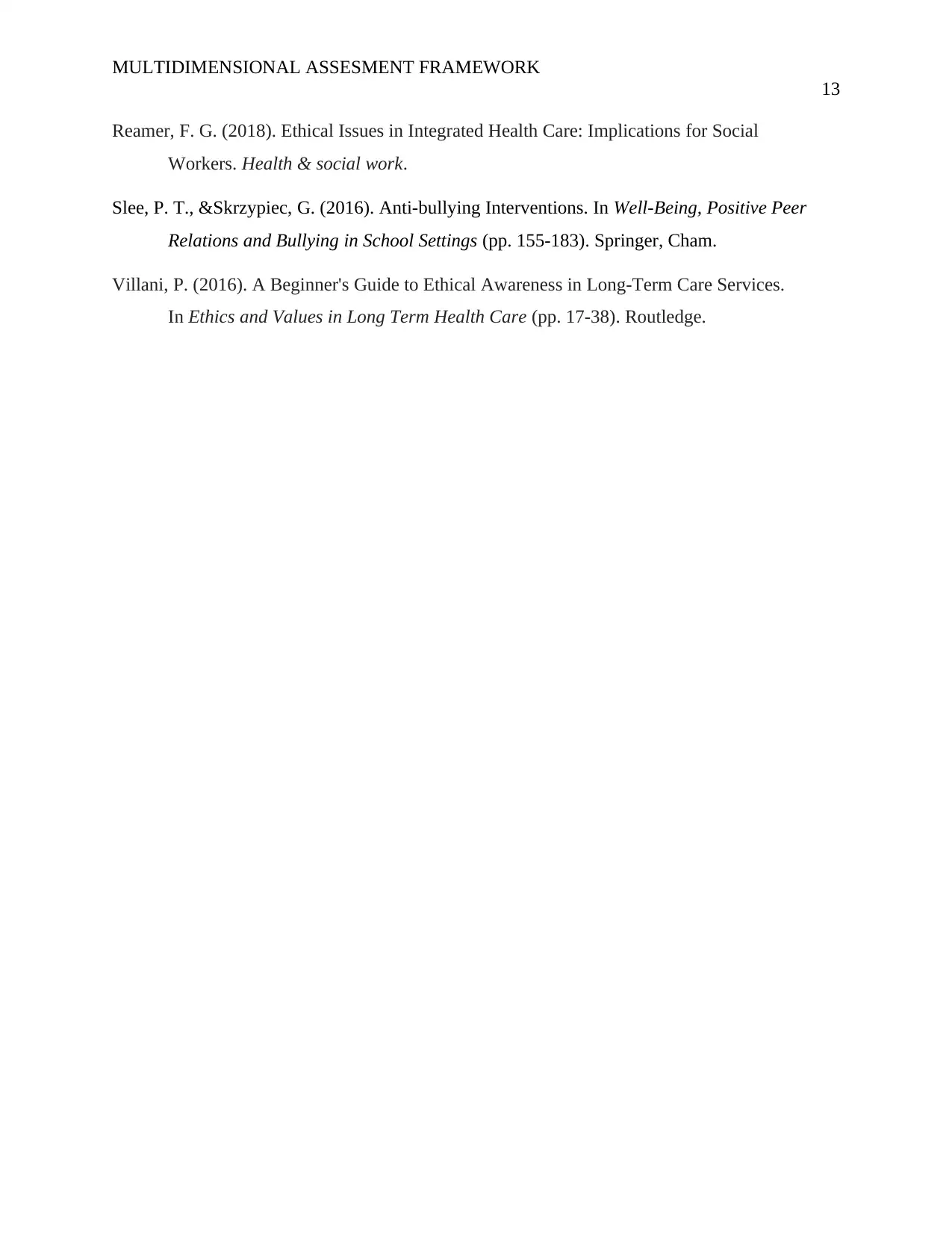
MULTIDIMENSIONAL ASSESMENT FRAMEWORK
13
Reamer, F. G. (2018). Ethical Issues in Integrated Health Care: Implications for Social
Workers. Health & social work.
Slee, P. T., &Skrzypiec, G. (2016). Anti-bullying Interventions. In Well-Being, Positive Peer
Relations and Bullying in School Settings (pp. 155-183). Springer, Cham.
Villani, P. (2016). A Beginner's Guide to Ethical Awareness in Long-Term Care Services.
In Ethics and Values in Long Term Health Care (pp. 17-38). Routledge.
13
Reamer, F. G. (2018). Ethical Issues in Integrated Health Care: Implications for Social
Workers. Health & social work.
Slee, P. T., &Skrzypiec, G. (2016). Anti-bullying Interventions. In Well-Being, Positive Peer
Relations and Bullying in School Settings (pp. 155-183). Springer, Cham.
Villani, P. (2016). A Beginner's Guide to Ethical Awareness in Long-Term Care Services.
In Ethics and Values in Long Term Health Care (pp. 17-38). Routledge.
1 out of 13
Your All-in-One AI-Powered Toolkit for Academic Success.
+13062052269
info@desklib.com
Available 24*7 on WhatsApp / Email
![[object Object]](/_next/static/media/star-bottom.7253800d.svg)
Unlock your academic potential
© 2024 | Zucol Services PVT LTD | All rights reserved.




